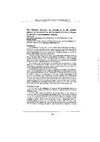Please use this identifier to cite or link to this item:
https://accedacris.ulpgc.es/handle/10553/74615
| Title: | The Micellar Systems: an alternative to the organic solvents to the extraction and preconcentration of organic pollutants in environmental samples | Authors: | Santana-Rodriguez, Jose J. Sosa Ferrera, María Zoraida Padrón Sanz, Carolina Mahugo Santana,Cristina Isabel |
UNESCO Clasification: | 2301 química analítica 2391 Química ambiental |
Keywords: | Extraction Environmental samples |
Issue Date: | 2003 | Conference: | IV European Meeting on Chemical Industry and Environment | Abstract: | The establishment of simple, fast, low cost, sensitive and selective analytical methods to determine the preserii nf po!!ofant~ In the environment Ls me of &e maln rew& !ines in the environmental chemistry field. Because of the complexity of these natural sarnples, the analytical melhodologies to be applied require several separationlextraction steps prior to the analysis, which normally becomes long and tedious. Normally, these previous steps are carried out by using organic solvenls as extractants, either alone (liquid-liquid extraction in liquid sarnplcs) or assisted by microwaves (solid sarnples). In rectnt studies, it has been dernonstmted that micellar systems (surfactant solutions) constitute a real altemative to the organic.solvents in order to be used as emctants of organic pollutants in liquid and solid environmental samples . Thesc rnicellar media may be used to the extraction and preconcentration of different analytes in liquid environmental samples, using the so called Cloud Point Extraction (CPE) methodology. In this methodolo~y srnall volurnes of the surfactant-Ach phase allows the preconcentration and extraction of the analytes in one step. In other hand, the cornbination of the use of surfactants as extractants and the Microwave Assisted Extraction has led to a new and efficient methodology to the extraction oí' different compounds in solid sampes: Microwave Assisted Micellar Extraction (MAME). In this work we present a auciy of the appiication oí CPE and MAME methodoiogies to the estraction/preconcentration and detenninati'on of organic pollutants like Polychlorinated Biphenyls, Polychlorinated Dibenzofurans. Polychlorinated Dibenzo-p-Diorins and Phenolic derivatives in natural, waste and sea water samples as well as in rnarine sediments and rnarine organisms samples. The obtained results are compared with those found using conventional estraction tcchniques likc liquid-liquid estraction and soshlet extraction. These studies show ihc advanlages oi ihae optimised methodologies respect lo the rradiiional rechniques. | URI: | https://accedacris.ulpgc.es/handle/10553/74615 | ISBN: | 8489528608 | Source: | IV European Meeting on Chemical Industry and Environment (4º. Las Palmas de Gran Canaria): Chemical industry and environment IV / Edited by Agustín Macías Machín and Jesús Joaquín Umbría Ramos, p. 413-422 |
| Appears in Collections: | Actas de congresos |
Page view(s)
135
checked on Jul 5, 2025
Download(s)
95
checked on Jul 5, 2025
Google ScholarTM
Check
Altmetric
Share
Export metadata
Items in accedaCRIS are protected by copyright, with all rights reserved, unless otherwise indicated.
